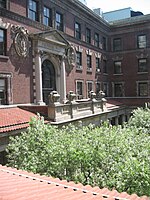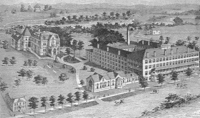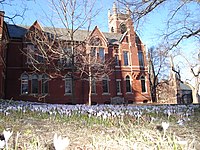Seven Sisters (colleges)
| Seven Sisters | |
|---|---|
| Data | |
| Established | 1927 |
| Continent | North America |
| Country | United States |
| University type | Private liberal arts college |
The Seven Sisters are seven liberal arts colleges in the Northeastern United States that are historically women's colleges. They are Barnard College, Bryn Mawr College, Mount Holyoke College, Radcliffe College, Smith College, Vassar College, and Wellesley College. All were founded between 1837 and 1889. Four are in Massachusetts, two are in New York, and one is in Pennsylvania. Radcliffe (which merged with Harvard College) and Vassar (which is now coeducational) are no longer women's colleges.
Seven Sisters colleges
| Institution | Location | School type | Full-time enrollment | Opened door to students | Collegiate Charter |
|---|---|---|---|---|---|
| Mount Holyoke Female Seminary (now Mount Holyoke College) |
South Hadley, Massachusetts | Private women's college | 2,100 | 1837 | 1888 |
| Vassar College | Poughkeepsie, New York | Private coeducational | 2,400 | 1865-1969 (women's college) 1969-present (coeducational) |
1861 |
| Wellesley College | Wellesley, Massachusetts | Private women's college | 2,300 | 1875 | 1870 |
| Smith College | Northampton, Massachusetts | Private women's college | 2,750 | 1875 | 1871 |
| The Harvard Annex (became Radcliffe College) |
Cambridge, Massachusetts | Radcliffe Institute for Advanced Study (no longer accepts students) | n/a | 1879-1999 (women's college) 1999-present (Institute) |
1894 |
| Bryn Mawr College | Bryn Mawr, Pennsylvania | Private women's college | 1,229 | 1885 | 1885 |
| Barnard College | Morningside Heights, Manhattan, New York | Private women's college | 2,356 | 1889 | 1889 |
History






Background
Irene Harwarth, Mindi Maline, and Elizabeth DeBra note that "Independent nonprofit women’s colleges, which included the 'Seven Sisters' and other similar institutions, were founded to provide educational opportunities to women equal to those available to men and were geared toward women who wanted to study the liberal arts".[1] The colleges also offered broader opportunities in academia to women, hiring many female faculty members and administrators.
Early proponents of education for women were Sarah Pierce (Litchfield Female Academy, 1792); Catharine Beecher (Hartford Female Seminary, 1823); Zilpah P. Grant Banister (Ipswich Female Seminary, 1828); and Mary Lyon. Lyon was involved in the development of both Hartford Female Seminary and Ipswich Female Seminary. She was also involved in the creation of Wheaton Female Seminary (now Wheaton College, Massachusetts) in 1834. In 1837, Lyon founded Mount Holyoke Female Seminary (Mount Holyoke College), the "first of the Seven Sisters."[2] Mount Holyoke received its collegiate charter in 1888 and became Mount Holyoke Seminary and College. It became Mount Holyoke College in 1893. Harwarth, Maline, and DeBra note that, "Mount Holyoke’s significance is that it became a model for a multitude of other women’s colleges throughout the country."[1] Both Vassar College and Wellesley College were patterned after Mount Holyoke.[3] Vassar was the first of the Seven Sisters to be chartered as a college in 1861.
Wellesley College was chartered in 1870 as the Wellesley Female Seminary, and was renamed Wellesley College in 1873. It opened its doors to students in 1875. Radcliffe College was originally created in 1879 as The Harvard Annex for women's instruction by Harvard faculty. It was chartered as Radcliffe College by the Commonwealth of Massachusetts in 1894. Barnard College became affiliated with Columbia University in 1900, but it continues to be independently governed. Smith College was chartered in 1871 and opened its doors in 1875. Bryn Mawr opened in 1885.
Mount Holyoke College and Smith College are also members of Pioneer Valley's Five Colleges consortium. Bryn Mawr College is a part of the Tri-College Consortium in suburban Philadelphia, with its sister schools, Haverford College and Swarthmore College.
Formation and name
Harwarth, Maline, and DeBra also state that "the 'Seven Sisters' was the name given to Barnard, Smith, Mount Holyoke, Vassar, Bryn Mawr, Wellesley, and Radcliffe, because of their parallel to the Ivy League men’s colleges" in 1927.[1][4]
The name, Seven Sisters, is a reference to the Greek myth of The Pleiades (mythology), the seven daughters of the Titan Atlas and the sea-nymph Pleione. The daughters were collectively referred to as The Seven Sisters and included, Maia, Electra, Taygete, Alcyone, Celaeno, Sterope, and Merope. In the field of astronomy, a cluster of stars in the constellation Taurus is also referred to as The Pleiades (star cluster) or the Seven Sisters.
The question of coeducation
The seven colleges explored the issue of coeducation in a variety of ways. Two of them, Radcliffe College and Vassar College are no longer women's colleges. Radcliffe has merged with Harvard University and is now defunct. Beginning in 1963, students at Radcliffe received Harvard diplomas signed by the presidents of Radcliffe and Harvard and joint commencement exercises began in 1970. The same year, several Harvard and Radcliffe dormitories began swapping students experimentally and in 1972 full co-residence was instituted. The departments of athletics of both schools merged shortly thereafter. In 1977, Harvard and Radcliffe signed an agreement which put undergraduate women entirely in Harvard College. In 1999 Radcliffe College was dissolved and Harvard University assumed full responsibility over the affairs of female undergraduates. Radcliffe is now the Radcliffe Institute for Advanced Study in Women's Studies at Harvard University. In addition, Vassar declined an offer to merge with Yale University and instead became coeducational in 1969.
Barnard College and Bryn Mawr College developed interactive systems with neighboring male (and later coeducational) colleges. Beginning in 1900, Barnard was included in the educational system of Columbia University, but it continued to be independently governed, while making available to its students the instruction and the facilities. Barnard currently pays an annual fee to Columbia to maintain its affiliation as the sister school of Columbia College. Columbia College began admitting women in 1983 after a decade of failed negotiations with Barnard for a merger along the lines of the one between Harvard College and Radcliffe College. Barnard has an independent faculty and board of trustees. Most of the school's classes and activities, however, are open to all members of Columbia University, male or female, in a reciprocal arrangement to benefit the academic and social life of the entire University community[5]. In addition, in 1969 Bryn Mawr and Haverford College (then all-male) developed a system of sharing residential colleges. When Haverford became coeducational in 1980, Bryn Mawr discussed the possibly of coeducation as well but decided against it.[6]
As with Bryn Mawr, Mount Holyoke College, Smith College, and Wellesley College decided against adopting coeducation. Mount Holyoke engaged in a lengthy debate under the presidency of David Truman over the issue of coeducation. On 6 November 1971, "after reviewing an exhaustive study on coeducation, the board of trustees decided unanimously that Mount Holyoke should remain a women's college, and a group of faculty was charged with recommending curricular changes that would support the decision."[7] Smith also made a similar decision in 1971.[8] Two years later, Wellesley also announced that it would not adopt coeducation.[9]
A June 03 2008 article in The New York Times discussed the move by women's colleges in the United States to promote their schools in the Middle East. The article noted that in doing so, the schools promote the work of graduates of women's colleges such as Hillary Rodham Clinton, Emily Dickinson, Diane Sawyer, Katharine Hepburn and Madeleine K. Albright. The Dean of Admissions of Bryn Mawr College noted, "We still prepare a disproportionate number of women scientists [...] We’re really about the empowerment of women and enabling women to get a top-notch education." The article also contrasted the difference between women's colleges in the Middle East and "the American colleges [which] for all their white-glove history and academic prominence, are liberal strongholds where students fiercely debate political action, gender identity and issues like “heteronormativity,” the marginalizing of standards that are other than heterosexual. Middle Eastern students who already attend these colleges tell of a transition that can be jarring." The article further quoted a Sri Lankan student (who had attended a coeducational school in Dubai) who stated that she was "shocked by the presence of so many lesbians among the students" and the "open displays of affection."[10]
Transgender issues
Recently, there has been discussion and controversy over how to accommodate transgender inclusion at the remaining women's colleges. This has risen to attention due to a small, yet increasing number of students that have in the course of their times at the colleges transitioned their gender from female to male (transman).[11]
Seven Sister colleges in popular culture
In the 2003 Simpsons episode "I'm Spelling As Fast As I Can", Lisa Simpson dreams that personifications of each of the Seven Sisters colleges are attempting to woo her into attending. Their personalities are stereotyped as:
- Barnard: Columbia's girl next door.
- Radcliffe: Meeting Harvard men.
- Wellesley: Marrying Harvard men.
- Mount Holyoke: Partying (before passing out).
- Vassar: Alternative lifestyles (while showing unshaven armpits).
- Smith: Athleticism (and implied homosexuality)
- Bryn Mawr: Experimenting (followed by making out with Smith girl).[12]
The 1978 film National Lampoon's Animal House satirizes a common practice (until the mid-1970s), when women attending Seven Sister colleges were connected with or to students at Ivy League schools. The film, which takes place in 1962, shows fraternity brothers from Delta House of the fictional Faber College (based on Dartmouth College) taking a road trip to the fictional Emily Dickinson College (based on Smith College).[13]
See also
- List of current and historical women's universities and colleges in the United States
- Timeline of women's colleges in the United States
- Women's colleges in the United States
- Women's colleges in the Southern United States
- Women's College Coalition
References
- Creighton, Joanne V. A Tradition of Their Own: Or, If a Woman Can Now Be President of Harvard, Why Do We Still Need Women’s Colleges?.
- Howard Greene (2000). Greenes' Guides to Educational Planning: The Hidden Ivies: Thirty Colleges of Excellence. New York: HarperCollins. ISBN 0-06-095362-4.
{{cite book}}: Unknown parameter|coauthors=ignored (|author=suggested) (help) - Horowitz, Helen Lefkowitz. Alma Mater: Design and Experience in the Women's Colleges from Their Nineteenth-Century Beginnings to the 1930s, Amherst: University of Massachusetts Press, 1993 (2nd edition).
- Perkins, Linda M. (1998). "The Racial Integration of the Seven Sister Colleges" ([dead link] – Scholar search). Journal of Blacks in Higher Education: 104–08. doi:10.2307/2998936.
{{cite journal}}: External link in|format=|month=ignored (help)
Notes
- ^ a b c Irene Harwarth. "Women's Colleges in the United States: History, Issues, and Challenges". U.S. Department of Education National Institute on Post-secondary Education, Libraries, and Lifelong Learning.
{{cite web}}: Unknown parameter|coauthors=ignored (|author=suggested) (help) - ^ "About Mount Holyoke". mountholyoke.edu. Retrieved 2006-09-01.
- ^ Jennifer L. Crispen. "Seven Sisters and a Country Cousin". sbc.edu.
{{cite web}}: Cite has empty unknown parameter:|coauthors=(help) - ^ Robert A. McCaughey (Spring 2003). "Women and the Academy". Higher Learning in America, History BC4345x. Barnard College.
- ^ The Barnard / Columbia Partnership, accessed July 26, 2006
- ^ "A Brief history of Bryn Mawr College". brynmawr.edu.
- ^ "Mount Holyoke:A Detailed History". mtholyoke.edu.
- ^ "Smith Tradition". smith.edu.
- ^ "WELLESLEY SAYS IT WON'T GO COED". New York Times. March 9, 1973.
{{cite news}}: Italic or bold markup not allowed in:|publisher=(help) - ^ ‘Sisters’ Colleges See a Bounty in the Middle East
- ^ "When She Graduates as He". The Boston Globe. April 8, 2007.
{{cite news}}: Italic or bold markup not allowed in:|publisher=(help) - ^ "Seven Sisters". Mount Holyoke College.
- ^ Landis, John (2003-08-29). (Interview). Interviewed by Soledad O'Brien http://cnnstudentnews.cnn.com/TRANSCRIPTS/0308/29/se.09.html.
{{cite interview}}: Missing or empty|title=(help); Unknown parameter|callsign=ignored (help); Unknown parameter|program=ignored (help); Unknown parameter|subjectlink=ignored (|subject-link=suggested) (help)
